How To Uninstall Xcode on Mac (Step-By-Step Guide)
Before we dive in
Before we dive in, let's make sure you stay safe online. We created SpyHunter because your security matters to us.
Protect your computer today — download SpyHunter right here! Check out our top tips below to keep your computer safe and secure.

Xcode is an integrated development environment (IDE) provided by Apple. It is essential for developers to create software for macOS, iOS, watchOS, and tvOS.
However, there may come a time when you need to uninstall Xcode from your Mac.
Knowing the right way to uninstall Xcode is crucial, whether you’re doing so to free up significant disk space, resolve software conflicts, or simply because you’re no longer using it.
This guide will walk you through the process, ensuring complete and efficient removal of the app and its associated files from your Mac.
Reasons to remove Xcode from Mac
You might decide to uninstall Xcode from your Mac for several reasons. Understanding these reasons can help you determine whether removing the Xcode app is the right step for you:
- Freeing Up Disk Storage: Xcode and its associated files can consume gigabytes of disk space. Uninstalling it can help you reclaim valuable storage for other important files and applications.
- Resolving Software Conflicts: Sometimes, the app may conflict with other installed programs, causing crashes or performance issues. Removing it can help restore system stability and improve overall performance.
- Reducing System Resource Usage: The app can consume considerable system resources, such as CPU and memory. Removing it can free up these resources, making your Mac run more efficiently, especially if you have limited hardware capabilities.
- No Longer Needed: If you’ve completed your development projects or switched to alternative development tools, you might no longer need the app. Deleting it can help streamline your applications and reduce clutter on your Mac.
- Troubleshooting Issues: If you encounter persistent problems with Xcode, such as failed updates or errors, deleting and reinstalling the IDE can sometimes resolve these issues. Starting fresh ensures that no corrupted files are left behind.
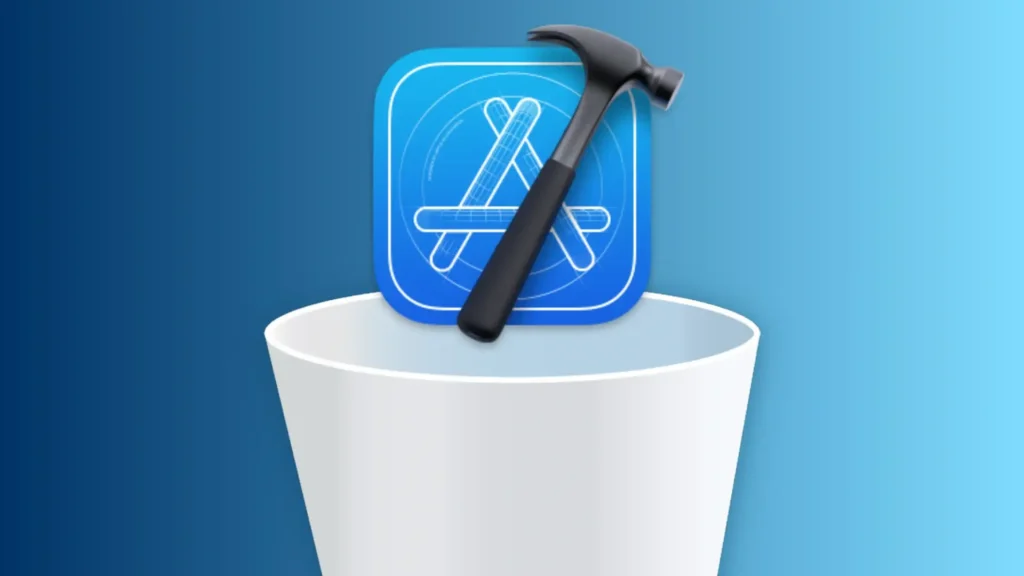
Consider these common reasons for uninstalling Xcode. Then, you can decide whether to remove the IDE from your Mac and proceed with the uninstallation process.
How to manually uninstall Xcode from Mac
Uninstalling Xcode from your Mac by hand involves several steps to ensure that all support files and components are removed.
Follow these instructions carefully to uninstall Xcode completely:
Step 1: Quit the Xcode application
Before you start the uninstallation process, ensure Xcode is not running.
Menu Bar Option: Click on the Xcode menu at the top of your screen and select Quit Xcode from the dropdown.
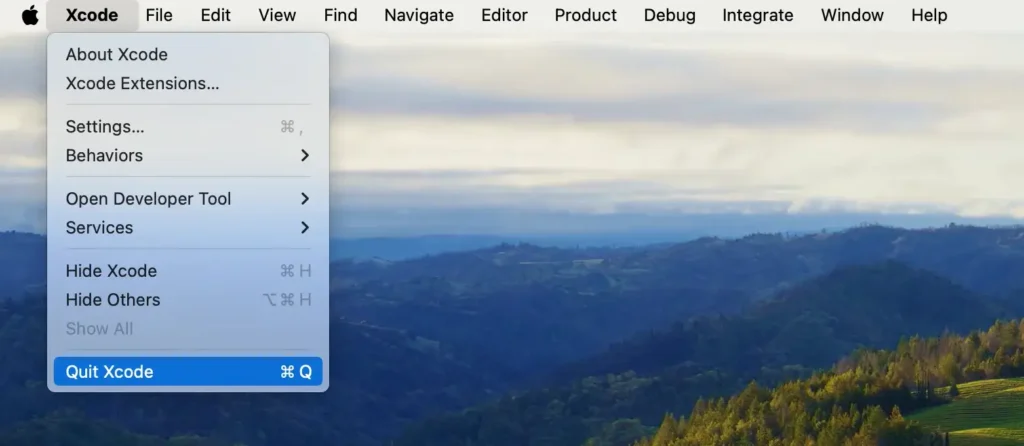
Dock Option: Alternatively, if Xcode is in your Dock, right-click (or Control-click) the Xcode icon and choose Quit from the context menu.
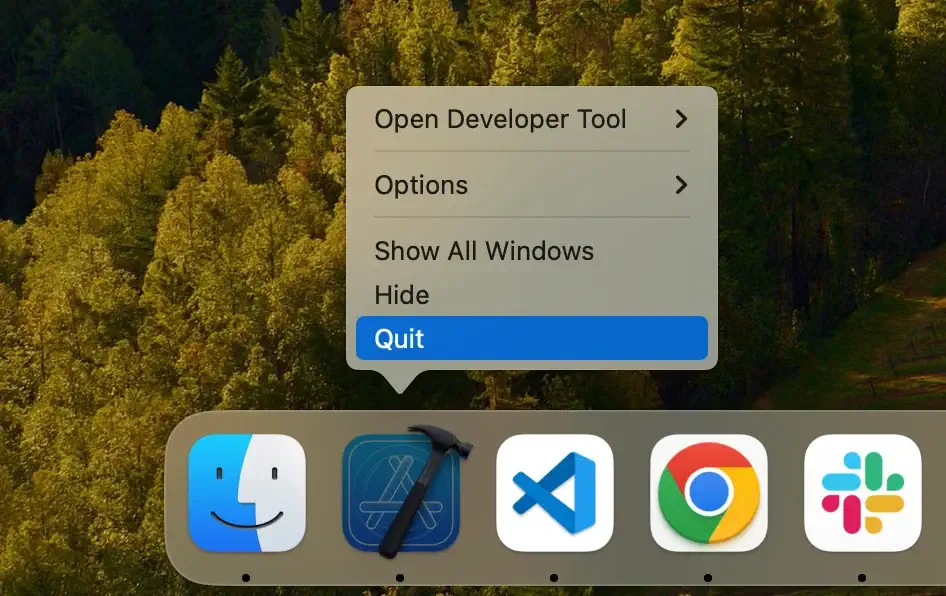
Force Quit via Activity Monitor: If the app is not responding, open Activity Monitor and search for any Xcode-related processes. Select them and click the [X] button to force quit the application.
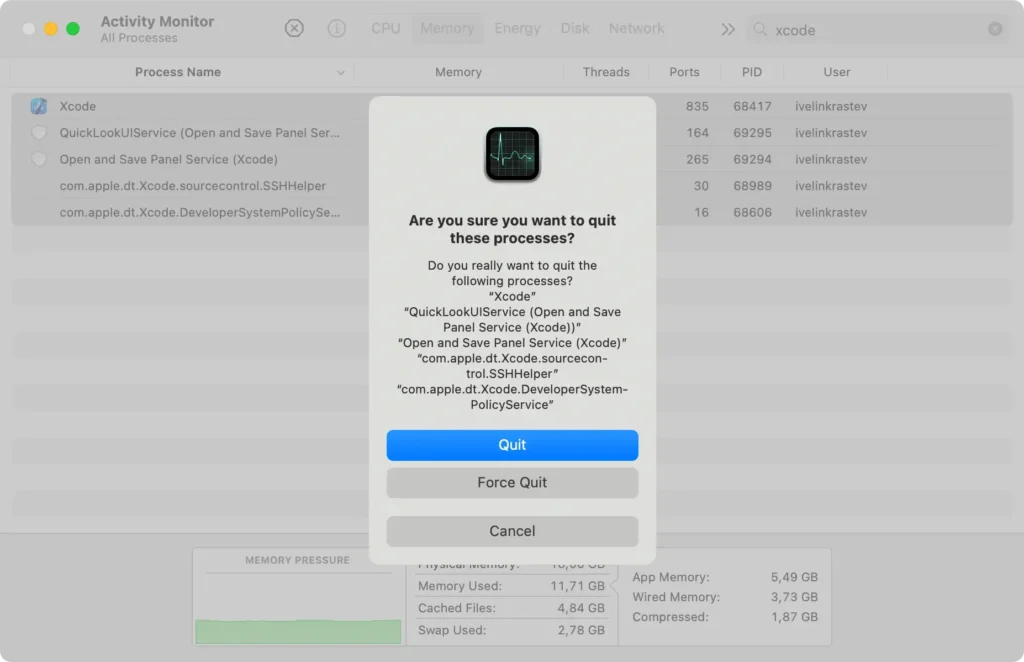
Step 2: Remove the Xcode app
To remove the main Xcode application from your Mac:
- Open a new
Finderwindow. - Navigate to the
Applicationsfolder from the sidebar. - Scroll through the list to locate the Xcode app.
- Drag Xcode to the Trash in your Dock. Alternatively, right-click (or Control-click) on Xcode and choose
Move to Trashfrom the dropdown menu. - Right-click on the Trash and select
Empty Trashto ensure the application is completely removed.
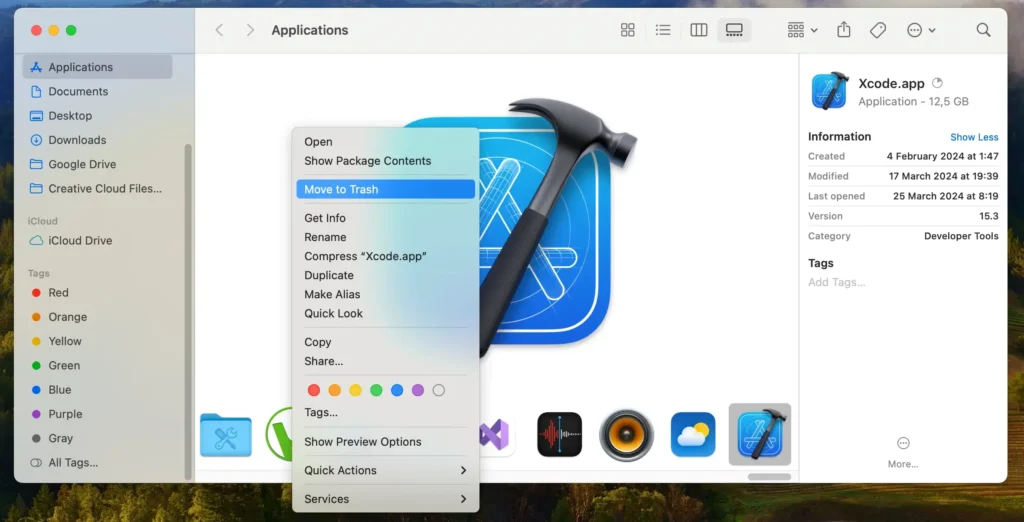
Step 3: Clean your Mac from Xcode files and folders
After deleting the Xcode app, the next crucial step is eliminating any remaining files and leftovers to ensure a complete cleanup.
Follow these steps:
- Launch
Finderon your Mac. - In the
Findermenu at the top of the screen, click theGomenu and thenGo to Folder…or use theShift + Command (⌘) + Gkeyboard shortcut. - One by one, enter the following paths into the search box to locate and remove Xcode’s associated files. For each path, look for any files or folders related to Xcode and move them to the Trash:
~/Library/Developer/~/Library/Application Support/~/Library/Logs//Library/Caches//Library/Developer/~/Library/Preferences/com.apple.dt.Xcode.plist
- After moving all related files and folders to the Trash, empty it to permanently delete them.
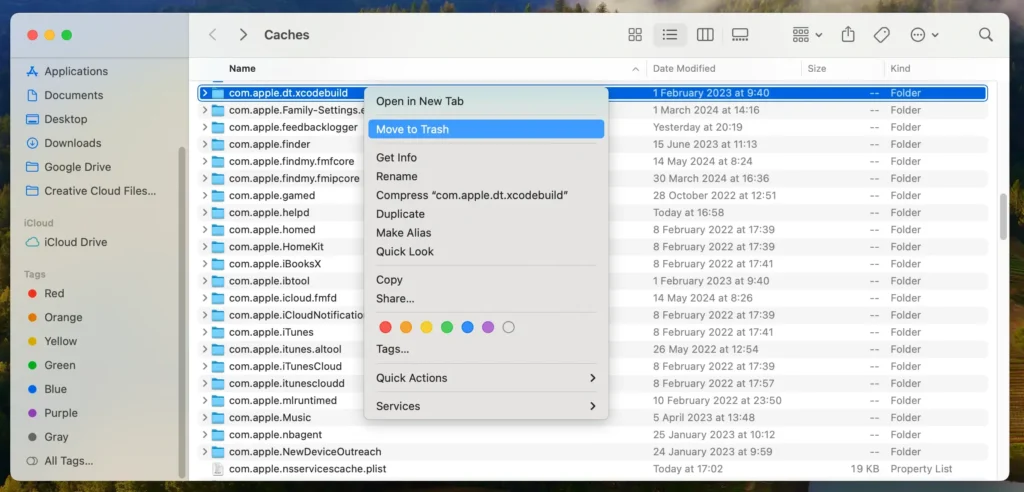
Manually removing Xcode involves more than just deleting the application itself.
Following these steps ensures that all support files are removed thoroughly, keeping your Mac clean and free from clutter.
Completely uninstall Xcode using SpyHunter
If you prefer a thorough and straightforward method to ensure that Xcode and all its associated files are entirely removed from your Mac, SpyHunter offers an efficient solution.
Follow these steps to use SpyHunter for a complete removal:
- Download SpyHunter for free here and follow the installation instructions.
- Open SpyHunter from your
Applicationsfolder. Go to theApp Uninstallerfeature, designed to scan your system and display all installed applications. - SpyHunter will automatically detect Xcode and its related files and components scattered across your system.
- After the scan completes, find Xcode in the list of applications. SpyHunter will list all the files associated with Xcode. Ensure that all checkboxes are selected to remove the complete set of files.
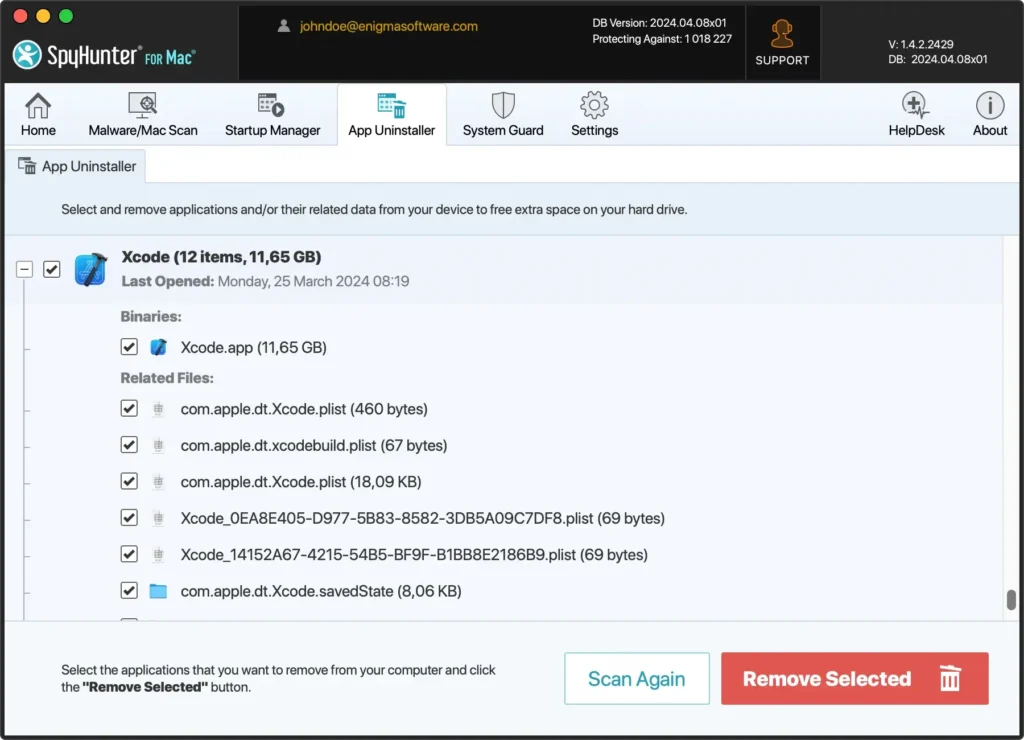
- Click on the
Remove Selectedbutton with all Xcode components selected. SpyHunter will handle the deletion process, removing all files from your system.
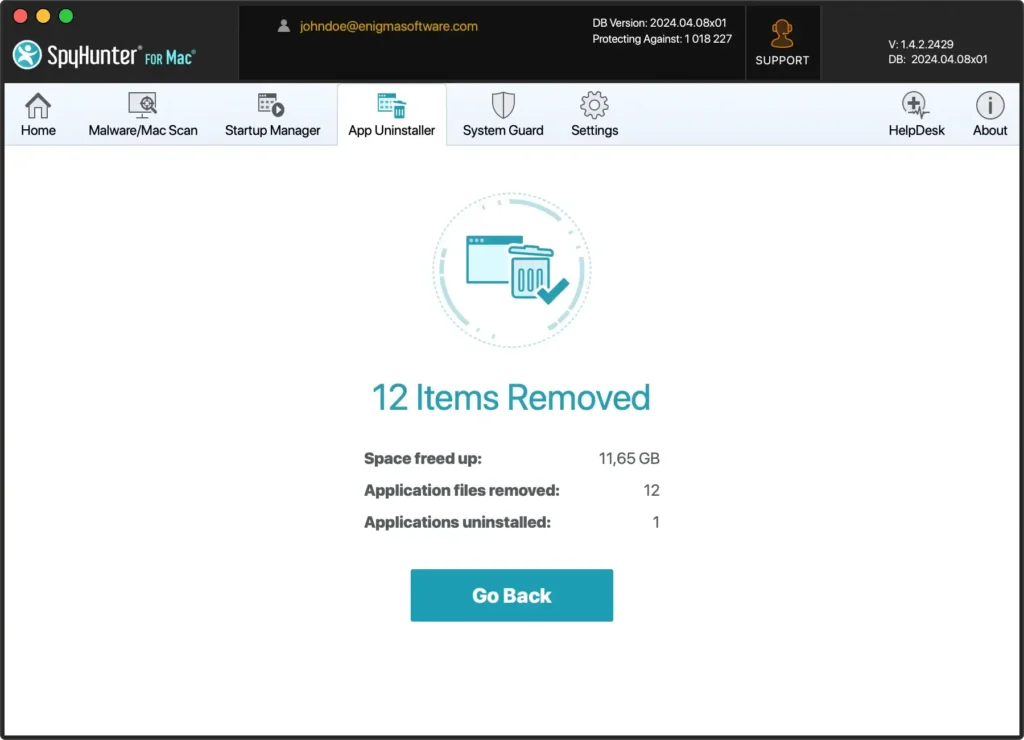
- After the uninstallation process, restart your computer to finalize the removal. Restarting ensures that all temporary files are cleared and system settings are updated.
Using SpyHunter to uninstall Xcode simplifies the process and ensures that no residual files are left behind.
This comprehensive cleanup helps maintain your Mac’s performance and prevents potential software conflicts.
Uninstall Xcode from Mac using Terminal commands
You can use Terminal commands to uninstall Xcode from your Mac for a more technical approach.
This method allows precise control over the removal process and ensures all associated files are completely deleted. Follow these steps:
- Open Terminal: Open the
Terminalapplication on your Mac. - Remove Additional Developer Tools: To ensure all related developer tools are removed, paste the following command into the
Terminalwindow:
sudo /Developer/Library/uninstall-devtools --mode=all- Delete Xcode Simulators: Use the next command to delete all simulators:
xcrun simctl delete all- Remove Xcode Application: Use the following command to remove the Xcode application:
sudo rm -rf /Applications/Xcode.app- Delete Xcode Residual Files: Execute the following commands to remove any remaining Xcode files:
sudo rm -rf ~/Library/Developer/CommandLineTools/
sudo rm -rf ~/Library/Developer/Xcode/
sudo rm -rf ~/Library/Application Support/Xcode
sudo rm -rf ~/Library/Caches/com.apple.dt.Xcode
sudo rm -rf ~/Library/Preferences/com.apple.dt.Xcode.plist
sudo rm -rf /Library/Preferences/com.apple.dt.Xcode.plistTerminal commands provide a precise and efficient way to uninstall Xcode, ensuring no residual files are left on your system.
How to re-install Xcode on Mac
If you need to reinstall Xcode on your Mac, follow these steps to get the setup right:
- Download Xcode:
- Open the App Store on your Mac.
- In the search bar, type
Xcodeand pressEnteron the keyboard. - Locate Xcode in the search results and click on the
Getbutton to download the latest version.
- Install Xcode:
- After the download is complete, Xcode will start the installation process. Follow the instructions to complete the installation.
- You may need to enter your Apple ID and/or administrative password to authorize the installation.
- Launch Xcode:
- After the installation is complete, open Xcode.
- On the first launch, Xcode may prompt you to install additional components. Follow the prompts to complete the setup.
- Set Up Your Development Environment:
- After launching Xcode, you can begin setting up your development environment. Install any necessary tools and extensions to tailor Xcode to your specific project needs.
Reinstalling Xcode is straightforward and ensures you have the current version with all the necessary components to continue your development work.
Summary
Removing Xcode from your device can help free up gigabytes of disk storage, resolve software conflicts, and optimize system performance.
Whether you manually remove Xcode, use Terminal commands, or employ SpyHunter for a thorough cleanup, understanding how to uninstall apps is crucial for maintaining your Mac’s health.
If you need to reinstall Xcode, the process is simple and can be done through the App Store. This ensures you have the latest version ready for your development projects.
For more detailed guides on managing your applications, check out our article on how to uninstall a Mac app.
With these instructions, you can effectively manage and uninstall apps on your Mac, ensuring a smooth and efficient system performance.